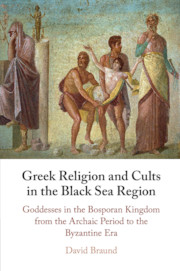Refine search
Actions for selected content:
23990 results in Ancient history
Chapter 1 - Aristocratic Dignity and Indignity in Republican Public Life
- from Part I - Modes of Political Communication
-
-
- Book:
- Institutions and Ideology in Republican Rome
- Published online:
- 08 May 2018
- Print publication:
- 17 May 2018, pp 15-34
-
- Chapter
- Export citation
Chapter 7 - The Garden and the Forum
- from Part II - Political Alliances
-
-
- Book:
- Institutions and Ideology in Republican Rome
- Published online:
- 08 May 2018
- Print publication:
- 17 May 2018, pp 147-164
-
- Chapter
- Export citation
Abbreviations
-
- Book:
- Jewish Childhood in the Roman World
- Published online:
- 08 June 2018
- Print publication:
- 17 May 2018, pp xxxi-xxxiv
-
- Chapter
- Export citation
Contents
-
- Book:
- Jewish Childhood in the Roman World
- Published online:
- 08 June 2018
- Print publication:
- 17 May 2018, pp v-vi
-
- Chapter
- Export citation
Acknowledgments
-
- Book:
- Freed Slaves and Roman Imperial Culture
- Published online:
- 09 May 2018
- Print publication:
- 17 May 2018, pp ix-x
-
- Chapter
- Export citation
Chapter 4 - Daughters
- from Part I - Theories
-
- Book:
- Jewish Childhood in the Roman World
- Published online:
- 08 June 2018
- Print publication:
- 17 May 2018, pp 131-169
-
- Chapter
- Export citation
Chapter 15 - Good Fortune and the Public Good
- from Part IV - Memory and Reputation
-
-
- Book:
- Institutions and Ideology in Republican Rome
- Published online:
- 08 May 2018
- Print publication:
- 17 May 2018, pp 283-298
-
- Chapter
- Export citation
Chapter 2 - Vagaries of Childhood
- from Part I - Theories
-
- Book:
- Jewish Childhood in the Roman World
- Published online:
- 08 June 2018
- Print publication:
- 17 May 2018, pp 35-91
-
- Chapter
- Export citation
Part III - Autobiographies
-
- Book:
- Jewish Childhood in the Roman World
- Published online:
- 08 June 2018
- Print publication:
- 17 May 2018, pp 265-376
-
- Chapter
- Export citation
Abbreviations
-
- Book:
- Institutions and Ideology in Republican Rome
- Published online:
- 08 May 2018
- Print publication:
- 17 May 2018, pp xii-xiv
-
- Chapter
- Export citation
Chapter 10 - When the Senators Became ‘The Best’
- from Part III - Institutions in Theory and Practice
-
-
- Book:
- Institutions and Ideology in Republican Rome
- Published online:
- 08 May 2018
- Print publication:
- 17 May 2018, pp 203-221
-
- Chapter
- Export citation
Bibliography
-
- Book:
- Jewish Childhood in the Roman World
- Published online:
- 08 June 2018
- Print publication:
- 17 May 2018, pp 390-438
-
- Chapter
- Export citation
Chapter 3 - Cultural Exchange in Roman Society
-
- Book:
- Freed Slaves and Roman Imperial Culture
- Published online:
- 09 May 2018
- Print publication:
- 17 May 2018, pp 73-103
-
- Chapter
- Export citation

Greek Religion and Cults in the Black Sea Region
- Goddesses in the Bosporan Kingdom from the Archaic Period to the Byzantine Era
-
- Published online:
- 16 May 2018
- Print publication:
- 31 May 2018
7 - The Immortality of Theseus and His Myth
-
-
- Book:
- Epic Heroes on Screen
- Published by:
- Edinburgh University Press
- Published online:
- 24 April 2021
- Print publication:
- 15 May 2018, pp 111-124
-
- Chapter
- Export citation
Broadcasting Greece: An Introduction to Greek Antiquity on the Small Screen
-
-
- Book:
- Ancient Greece on British Television
- Published by:
- Edinburgh University Press
- Published online:
- 24 April 2021
- Print publication:
- 15 May 2018, pp 1-23
-
- Chapter
- Export citation
11 - The Hero in a Thousand Pieces: Antiheroes in Recent Epic Cinema
-
-
- Book:
- Epic Heroes on Screen
- Published by:
- Edinburgh University Press
- Published online:
- 24 April 2021
- Print publication:
- 15 May 2018, pp 173-190
-
- Chapter
- Export citation
4 - Heroes and Companions in Hercules (2014)
-
-
- Book:
- Epic Heroes on Screen
- Published by:
- Edinburgh University Press
- Published online:
- 24 April 2021
- Print publication:
- 15 May 2018, pp 60-73
-
- Chapter
- Export citation
Frontmatter
-
- Book:
- Ancient Greece on British Television
- Published by:
- Edinburgh University Press
- Published online:
- 24 April 2021
- Print publication:
- 15 May 2018, pp i-iv
-
- Chapter
- Export citation
Part III - Women’s Weapons
-
- Book:
- Revenge and Gender in Classical, Medieval and Renaissance Literature
- Published by:
- Edinburgh University Press
- Published online:
- 06 May 2021
- Print publication:
- 15 May 2018, pp 139-140
-
- Chapter
- Export citation
